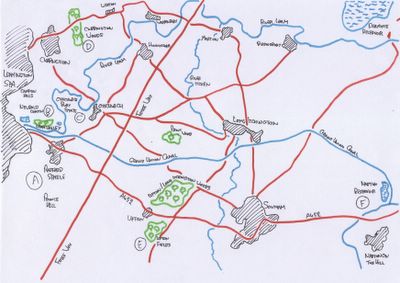
It is on the east side of the town, however, on a mixture of farmland, woods, reservoirs, rivers and a canal, that I do most of my birding. This is my 'patch', that local bit of turf that many if not most birders have. The map above shows the extent of this patch, including some of the key birding sites. The patch is broadly defined by two key waterways, the River Leam and the Grand Union Canal, and most of my key birding locations are either on or near one of these. My patch list, here, provides an updated list of all the birds I have seen on the patch.
I should point out that at the very northeast tip of the map, you can see Draycote Reservoir, one of the best known and most productive birding destinations in the Midlands. Although I do visit Draycote from time to time, particularly in the winter, I have deliberately excluded it from my patch notes and records. This is partly because there are already many excellent birders monitoring this area on a daily basis, and partly because its size and productivity makes it a patch in its own right - I simply couldn't do it justice with the time I have available.
However, the key areas that do make up my patch are:
A. Radford Semele
A village less than three miles from Leamington, surrounded on three sides by mixed-use agricultural land. The only water is a village pond, tucked out of sight on scrubland to the south. It is a favourite spot for a wide variety of typical farmland birds, including Yellowhammer, Sky Lark, Tree Sparrow, Yellow Wagtail, Buzzard and, in the winter, Lapwing and Fieldfare.
B. Leam Valley
The heart of my patch work, this local nature reserve (managed by Warwickshire Wildlife Trust) has a good variety of habitats including a flood plain (Welches Meadow), a reservoir (sadly locked and difficult to view), woodlands (both deciduous and coniferous), the River Leam itself, and a scrape, an open area of shallow pools overlooked by a hide. I also count in this area Newbold Comyn Park and little bit of the Offchurch Bury Estate, including some farmland, a weir and a stretch of reedy river. Leam Valley is probably the most diverse and productive part of the whole patch, and has been home to everything from Little Egrets to Long-tailed Tits , Green Woodpeckers to Goldcrests.
C. Offchurch and Offchurch Bury Estate
Offchurch is a lovely village surrounded by farmland, the Grand Union Canal, and the Offchurch Bury Estate, a large area of private parkland managed for equestrian events. This combination throws up good birds in and around the village - possibles include Little Owls on the estate, Spotted Flycatchers in the village churchyard and, although sadly I'm yet to see it, a Barn Owl over the farmland.
D. Cubbington Woods
This is the southern tip of Warwickshire's oldest area of woodland (the better known parts, Ryton, Wappenbury and Princethorpe, are just to the north). This whole area is well managed for conservation by the owners of Weston Hall Farm - there are wide grass and wildflower margins around the arable planting, restored and managed hedgerows throughout, and permission to access South Cubbington Wood itself. The result is some fantastic woodland birding, including classic birds like the Nuthatch, Treecreeper and Great Spotted Woodpecker. The nearby hedgerows and fields hold Yellowhammer, Linnet and Lesser Whitethroat.
E. Ufton Fields
This is another Warwickshire Wildlife Trust managed reserve, a mix of woodlands, pools and scrubland left after the industrial excavation of White Lias Limestone during the fifties. The reserve is small, but has a wide variety of habitats. It looks ideal for birding, but is a surprisingly hard place in which to find good birds. With some perserverence, however, I have found various warblers, Hobby, Green Woodpecker, Spotted Flycatcher, Marsh Tit, Bullfinch, and even a female Mandarin Duck! It is widely reported as a good place for Turtle Dove, but I have never found any here.
F. Napton Reservoir
A much smaller reservoir than Draycote, and a few kilometres to the south. This is the main deep water location in my patch, and so is useful for finding diving ducks and grebes. It also attracts a good range of passage birds, and some real rarities - a Ring-necked Duck in early 2006 for example. Alongside the deep water, its other attraction is a truly massive (by local standards) reedbed at the back - this means that the reservoir plays host to Reed Warblers, Reed Buntings, Sedge Warblers, and, very very occasionally, Bearded Tits and Cettis Warblers.
3 comments:
Hi - really interested to find and read your blog today. I used to be warden at Ufton Fields in the late 90s and haven't been there for over seven years, so it's interesting to read about the birds that you've seen. I added a few species to the reserve list in the four years that I visited regularly and can tell you that the female Mandarin was a first. You can see a species list for Ufton (from about 2001) at http://homepage.ntlworld.com/s_roper/uftonlist.htm
Post a Comment